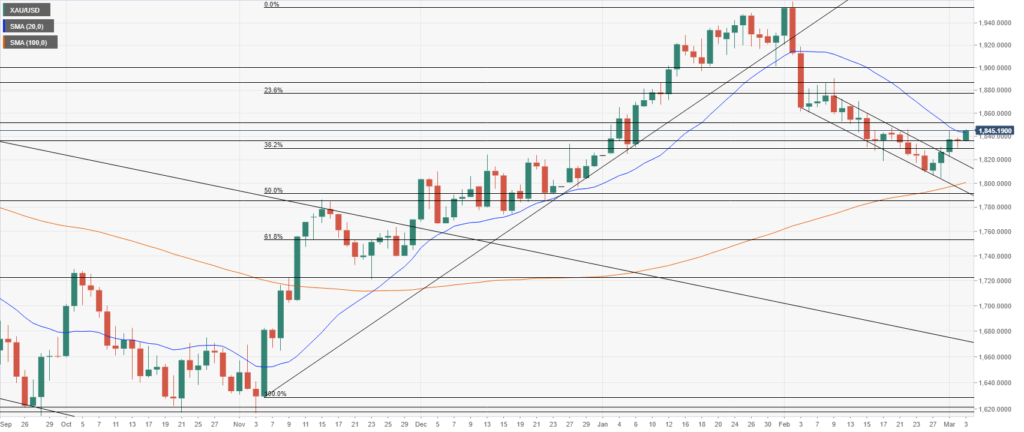In a positive reversal week, gold price bulls get active. Despite rising US Treasury 10-year bond rates, the US dollar has somewhat reversed. For a new thrust on XAU/USD, the ISM Services PMI is still awaiting publication.
This week saw the return of gold price bulls, which enabled the precious metal to exit the negative trend that had dominated XAU/USD price action in February. More impressively, Gold has managed to advance despite rising US Treasury bond rates, which typically benefit the US Dollar and hurt commodities with negative yields.
Gold news: China PMI rises
Positive PMI data from China, both in the manufacturing and services sectors, has significantly boosted demand for Gold since the Asian superpower is a significant market for yellow metals. Gold traders are now anticipating further Federal Reserve cues, which may come from comments made by Fed officials and Friday’s ISM Services PMI.
Investors continue to track the US 10-year Treasury bond yield market, which surged through the critical 4% barrier on Wednesday and is still above it. If US Treasury rates remain high, the typical inverse relationship between the gold price and yields might put downward pressure on the price of the US dollar (XAU/USD). Still, a correction in the bond market could send the yellow metal on a significant rise.
US Services PMIs will soon be released; watch for signs of inflation.
On Friday at 15 GMT, the Institute of Supply Management (ISM) will release the Services PMI. The US Dollar is expected to maintain its position against Gold if this research confirms that increasing labor expenses fuel escalating pricing pressures in the industry. Thus, market players will pay special attention to the Prices Paid Index component.

While the CME Group FedWatch Tool indicates that markets have completely priced in at least two further 25 basis point Federal Reserve rate rises in March and May, it is essential to note. Moreover, there is a 25% chance that the Fed will maintain its policy rate in June.
The February employment report and inflation statistics confirm or disprove one more 25-bps raise in June; at least, the US Dollar has little ability to rise, according to the market reversal.
According to Commerzbank, the gold price may have bottomed out.
According to Commerzbank analysts, the positive reversal witnessed this week suggests that the price of Gold may have started an uptrend:
The anticipated rate peak had been postponed until the fall at the end of the month, and it is now forecast to reach over 5.5%, which is around 70 basis points more than anticipated at the beginning of the month. Therefore, there is no longer any hope for rate reductions this year.
The price gain amid prospects for substantially rising interest rates may indicate that the gold price correction is essentially over and that the price may have bottomed out at the start of the week.
US Treasury bonds, the US dollar, and inflation dynamics influence the gold price.
Gold is a non-yielding asset that does not provide regular income, so its correlation with US Treasury bond rates is often negative. Throughout most of 2022, the benchmark US 10-year bond yield increased steadily in response to the Federal Reserve boosting interest rates to battle soaring inflation.
Early in 2023, there are still significant price pressures, but the Consumer Price Index (CPI) readings in the US and other major countries have begun to slow down. Economists expect this trend of disinflation to continue throughout the remainder of the year. If this trend continues, Gold’s price should be able to acquire some support from the demand side.
The Gold price (XAU/USD) should be tracked with other assets outside Treasury rates. The yellow metal is mainly traded in US Dollars, which makes it very susceptible to fluctuations in the foreign exchange market. As the USD strengthens relative to other essential currencies and emerges as the preferred asset, as it did for most of the past year, the price of Gold also tends to decline. There is a strong correlation between US Treasury rates and the US Dollar. Thus both dynamics are interwoven.
The gold price in 2023 will fluctuate.
Early in 2023, the financial markets were a two-tale tale, with Gold’s price reflected in its price behavior, unlike any other asset. The market’s confidence about inflation slowing down and the Federal Reserve’s consistent dovish commentary helped XAU/USD ride an uptrend throughout January, only to witness a sharp reversal back to the old dynamics in February after a strong US Nonfarm Payrolls (NFP) data. The US economy added more than 500K jobs in January, which changed market expectations for the Fed to loosen its monetary policy. As a result, the US Dollar has reclaimed its position as the market’s king.
The price of Gold started the year at $1,823.76. It rose to a year-to-date high of $1,960 on February 2, just before the start of the year’s first Federal Reserve meeting and the unexpected publication of the US employment data for January. From then, the price of Gold began a sharp decline, hitting yearly lows of just around $1,800 before finding support.


